Experimental Study on the Swelling Behavior of Expansive Soil at Different Depths under Unidirectional Seepage
Abstract
1. Introduction
2. Materials and Methods
2.1. Materials
2.2. Test Apparatus
2.3. Test Procedures
2.3.1. Sample Preparation
2.3.2. Model Elaboration
2.3.3. Cation Concentration Tests
2.3.4. Swelling Tests
3. Results and Discussions
3.1. Swelling Deformation of Expansive Soil Layer at Different Depths
3.2. Cation Concentration of Pore Solution
3.2.1. In the Saturated Process
3.2.2. After Completion of Model Test
3.3. Swelling Behavior of Expansive Soil at Different Depths
3.4. Discussions
4. Conclusions
Author Contributions
Funding
Conflicts of Interest
References
- Jones, L.D.; Jefferson, I. Expansive Soils; Inst. of Civ. Eng. Publ.: London, UK, 2012; pp. 413–441. [Google Scholar]
- Punthutaecha, K.; Puppala, A.J.; Vanapalli, S.K.; Inyang, H. Volume change behaviors of expansive soils stabilized with recycled ashes and fibers. J. Mater. Civ. Eng. 2006, 18, 295–306. [Google Scholar] [CrossRef]
- Nalbantoğlu, Z. Effectiveness of Class C fly ash as an expansive soil stabilizer. Constr. Build. Mater. 2004, 18, 377–381. [Google Scholar] [CrossRef]
- Reyes Martinez Belchior, I.M.; Casagrande, M.D.T.; Zornberg, J.G. Swelling Behavior Evaluation of a Lime-Treated Expansive Soil through Centrifuge Test. J. Mater. Civ. Eng. 2017, 29, 04017240. [Google Scholar] [CrossRef]
- Chen, F.H. Foundations on Expansive Soils; Elsevier: Amsterdam, The Netherlands, 1988. [Google Scholar]
- Cheng, Y.; Wang, S.; Li, J.; Huang, X.; Li, C.; Wu, J. Engineering and mineralogical properties of stabilized expansive soil compositing lime and natural pozzolans. Constr. Build. Mater. 2018, 187, 1031–1038. [Google Scholar] [CrossRef]
- Katti, R.K.; Katti, A.R. Behaviour of Saturated Expansive Soil and Control Methods; Oxford & IBH Pub. Co. Pvt. Ltd.: New Delhi, India, 1994. [Google Scholar]
- Katti, R.K. Coulumbian Cohesion Approach to Engineering of Expansive Soil Deposits: Field Performance. Adv. Unsaturated Geotech. 2000, 467–486. [Google Scholar] [CrossRef]
- Jenny, H.; Reitemeier, R.F. Ionic Exchange in Relation to the Stability of Colloidal Systems. J. Phys. Chem. 2002, 39, 593–604. [Google Scholar] [CrossRef]
- Li, Z.Y.; Liu, Y.; Zheng, Y.Y.; Xu, R.K. Zeta potential at the root surfaces of rice characterized by streaming potential measurements. Plant Soil. 2015, 386, 237–250. [Google Scholar] [CrossRef]
- Gao, G.R. Neoteric Soil Geotechnology, 2nd ed.; China Science Press: Beijing, China, 2013. (In Chinese) [Google Scholar]
- Tan, L.R. Study on Mechanism of Expansion and Shrinkage of the Montmorillonite Crystal. J. Rock Soil Mech. 1997, 18, 13–18. (In Chinese) [Google Scholar]
- Tan, L.R. Electrolyte Concentration Effect of Nonnormal Swelling of Montmorillonite Crystal. J. Acta Miner. Sin. 2002, 22, 371–374. (In Chinese) [Google Scholar]
- Ye, W.M.; Zhang, F.; Chen, Y.G.; Chen, B.; Cui, Y.J. Influences of salt solutions and salinization-desalinization processes on the volume change of compacted GMZ01 bentonite. Eng. Geol. 2017, 222, 140–145. [Google Scholar] [CrossRef]
- Norrish, K.; Quirk, J.P. Crystalline Swelling of Montmorillonite: Use of Electrolytes to Control Swelling. Nature 1954, 173, 255–256. [Google Scholar] [CrossRef]
- Liu, L.-N.; Chen, Y.-G.; Ye, W.-M.; Cui, Y.-J.; Wu, D.-B. Effects of hyperalkaline solutions on the swelling pressure of compacted Gaomiaozi (GMZ) bentonite from the viewpoint of Na+ cations and OH– anions. Appl. Clay Sci. 2018, 161, 334–342. [Google Scholar] [CrossRef]
- Lee, J.O.; Jin, G.L.; Kang, I.M.; Kwon, S. Swelling pressures of compacted Ca-bentonite. Eng. Geol. 2012, 129, 20–26. [Google Scholar] [CrossRef]
- Chen, Y.G.; Jia, L.Y.; Li, Q.; Ye, W.M.; Cui, Y.J.; Chen, B. Swelling deformation of compacted GMZ bentonite experiencing chemical cycles of sodium-calcium exchange and salinization-desalinization effect. Appl. Clay Sci. 2017, 141, 55–63. [Google Scholar] [CrossRef]
- Abdullah, W.S.; Alshibli, K.A.; Al-Zou’Bi, M.S. Influence of pore water chemistry on the swelling behavior of compacted clays. Appl. Clay Sci. 1999, 15, 447–462. [Google Scholar] [CrossRef]
- Wang, Q.; Cui, Y.J.; Tang, A.M.; Delage, P.; Gatmiri, B.; Ye, W.M. Long-term effect of water chemistry on the swelling pressure of a bentonite-based material. Appl. Clay Sci. 2014, 87, 157–162. [Google Scholar] [CrossRef]
- Zhu, C.M.; Ye, W.M.; Chen, Y.G.; Chen, B.; Cui, Y.J. Influence of salt solutions on the swelling pressure and hydraulic conductivity of compacted GMZ01 bentonite. Eng. Geol. 2013, 166, 74–80. [Google Scholar] [CrossRef]
- Castellanos, E.; Villar, M.V.; Romero, E.; Lloret, A.; Gens, A. Chemical impact on the hydro-mechanical behaviour of high-density FEBEX bentonite. Phys. Chem. Earth Parts A/B/C 2008, 33, S516–S526. [Google Scholar] [CrossRef]
- Muurinen, A.; Lehikonen, J. Porewater chemistry in compacted bentonite. Eng. Geol. 1999, 54, 207–214. [Google Scholar] [CrossRef]
- Mata, C.; Guimarães, L.; Do, N.; Ledesma, A.; Gens, A.; Olivella, S. A hydro-geochemical analysis of the saturation process with salt water of a bentonite crushed granite rock mixture in an engineered nuclear barrier. Eng. Geol. 2005, 81, 227–245. [Google Scholar] [CrossRef]
- Ministry of Transport of the People’s Republic of China. Test Methods of Soils for Highway Engineering (JTG E40-2007); China Communications Press: Beijing, China, 2015. (In Chinese) [Google Scholar]
- Yao, H.L.; Yang, Y.; Cheng, P.; Wu, W.P. Standard moisture absorption water content of soil and its testing standard. J. Rock Soil Mech. 2004, 25, 856–859. (In Chinese) [Google Scholar]
- Savage, D. The Effects of High Salinity Groundwater on the Performance of Clay Barriers; SKI Report 54; Swedish Nuclear Power Inspectorate: Stockholm, Sweden, 2005. [Google Scholar]
- Madsen, F.T.; Müller-Vonmoos, M. The swelling behaviour of clays. Appl. Clay Sci. 1989, 4, 143–156. [Google Scholar] [CrossRef]
- Suzuki, S.; Prayongphan, S.; Ichikawa, Y.; Chae, B.G. In situ observations of the swelling of bentonite aggregates in NaCl solution. Appl. Clay Sci. 2005, 29, 89–98. [Google Scholar] [CrossRef]
- Tripathy, S.; Sridharan, A.; Schanz, T. Swelling pressures of compacted bentonites from diffuse double layer theory. Can. Geotech. J. 2004, 41, 437–450. [Google Scholar] [CrossRef]
- Raymond, N.Y.; Benno, P.W. Soil Properties and Behaviour; Elsevier: Amsterdam, The Netherlands, 1975. [Google Scholar]
- Mitchell, J.K.; Soga, K.; Mitchell, J.K.; Soga, K. Fundamentals of Soil Behavior; John Wiley & Sons: New York City, NY, USA, 1976. [Google Scholar]
- Devineau, K.; Bihannic, I.; Michot, L.; Villiéras, F.; Masrouri, F.; Cuisinier, O.; Fragneto, G.; Michau, N. In situ neutron diffraction analysis of the influence of geometric confinement on crystalline swelling of montmorillonite. Appl. Clay Sci. 2006, 31, 76–84. [Google Scholar] [CrossRef]
- Baver, L.D. Soil Physics, 3rd ed.; John Wiley & Sons: New York City, NY, USA, 1956. [Google Scholar]
- Behzad, K. Foundations on Expansive Soils: A Review. Res. J. Appl. Sci. Eng. Technol. 2012, 4, 3231–3237. [Google Scholar]
- John, D.N.; Daniel, D.O.; Dean, B.D. Depth of Wetting and the Active Zone. Expansive Clay Soils and Vegetative Influence on Shallow Foundations. In Proceedings of the Geotechnical Sessions at the 2001 Annual Civil Engineering Conference, Houston, TX, USA, 19–24 August 2001; pp. 95–109. [Google Scholar]
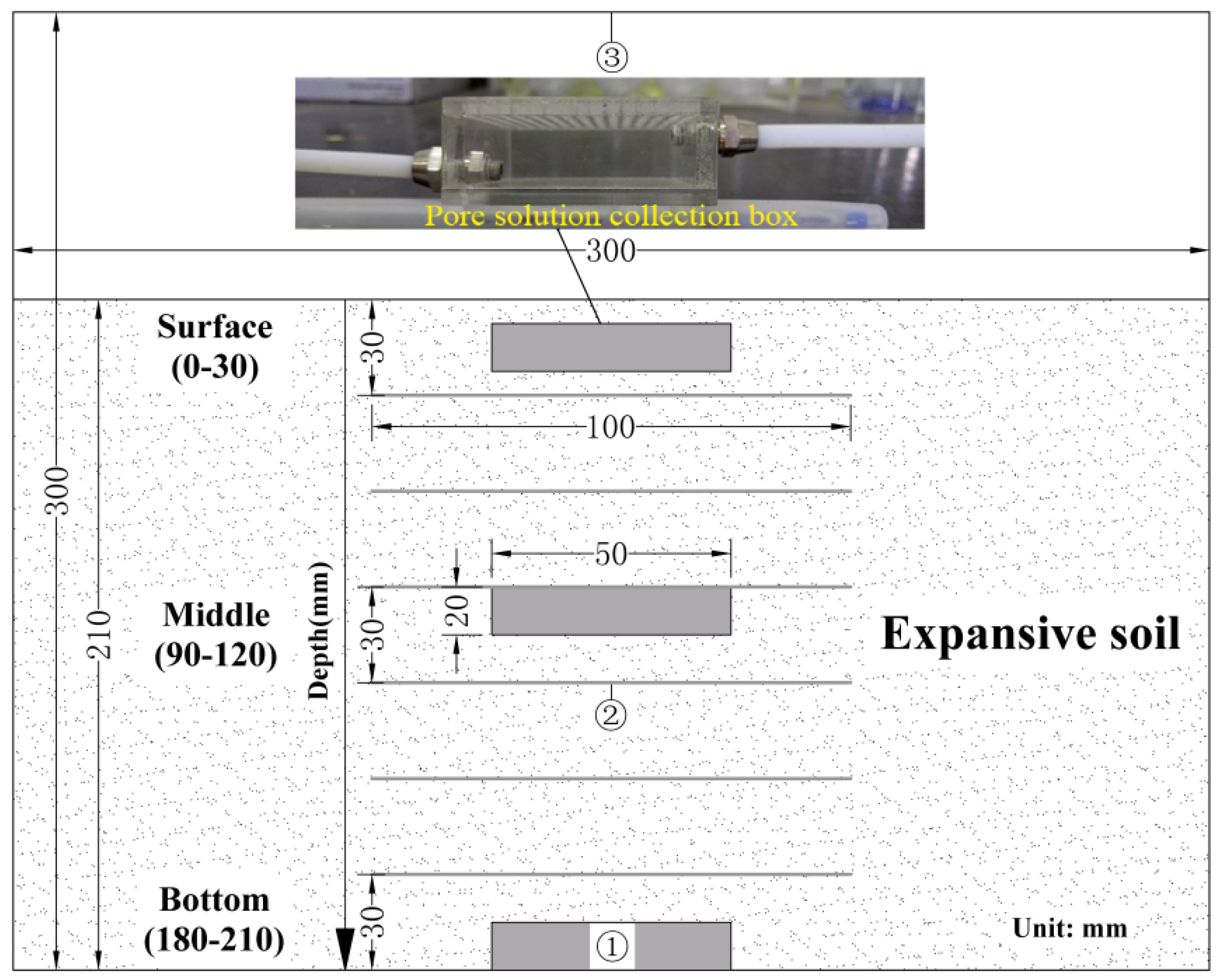
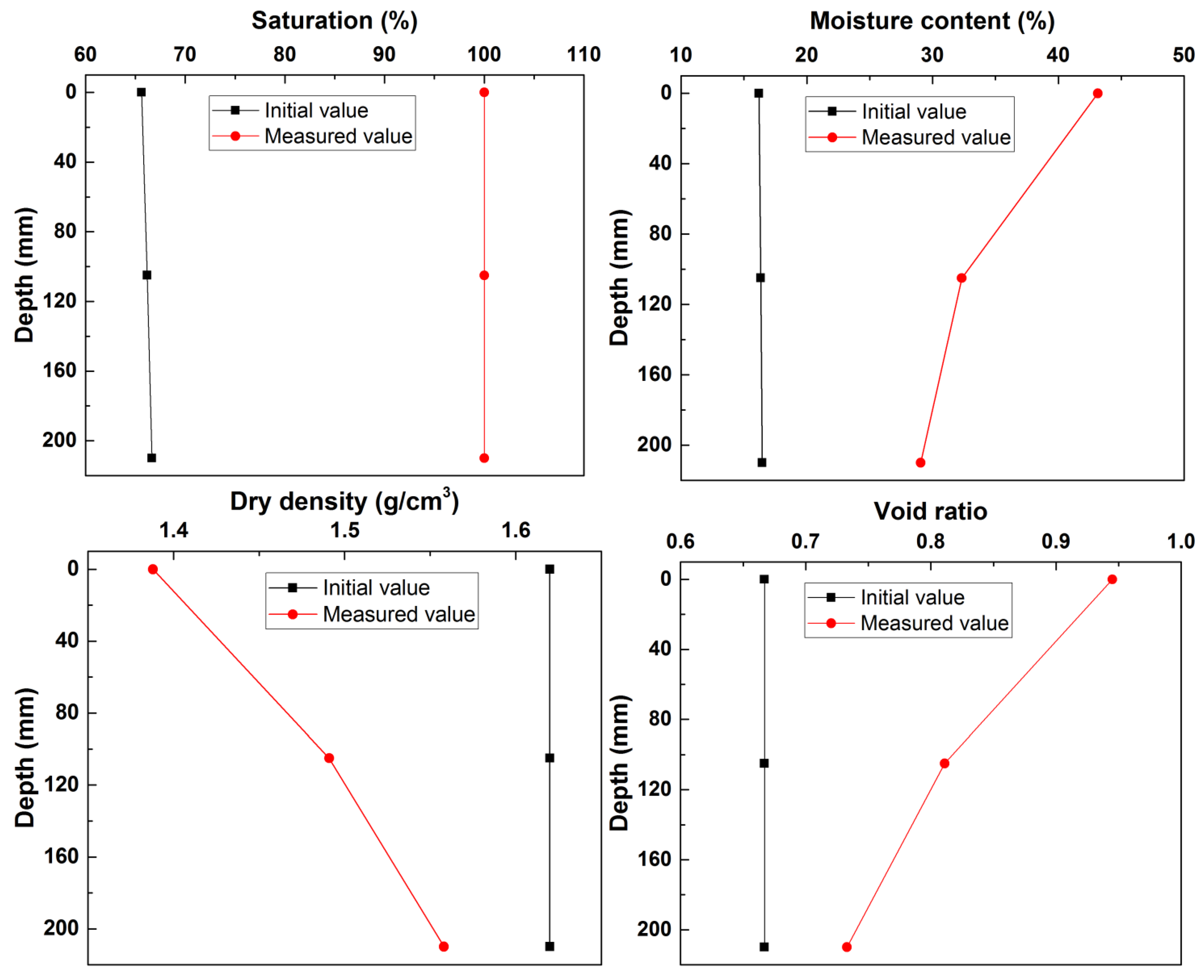
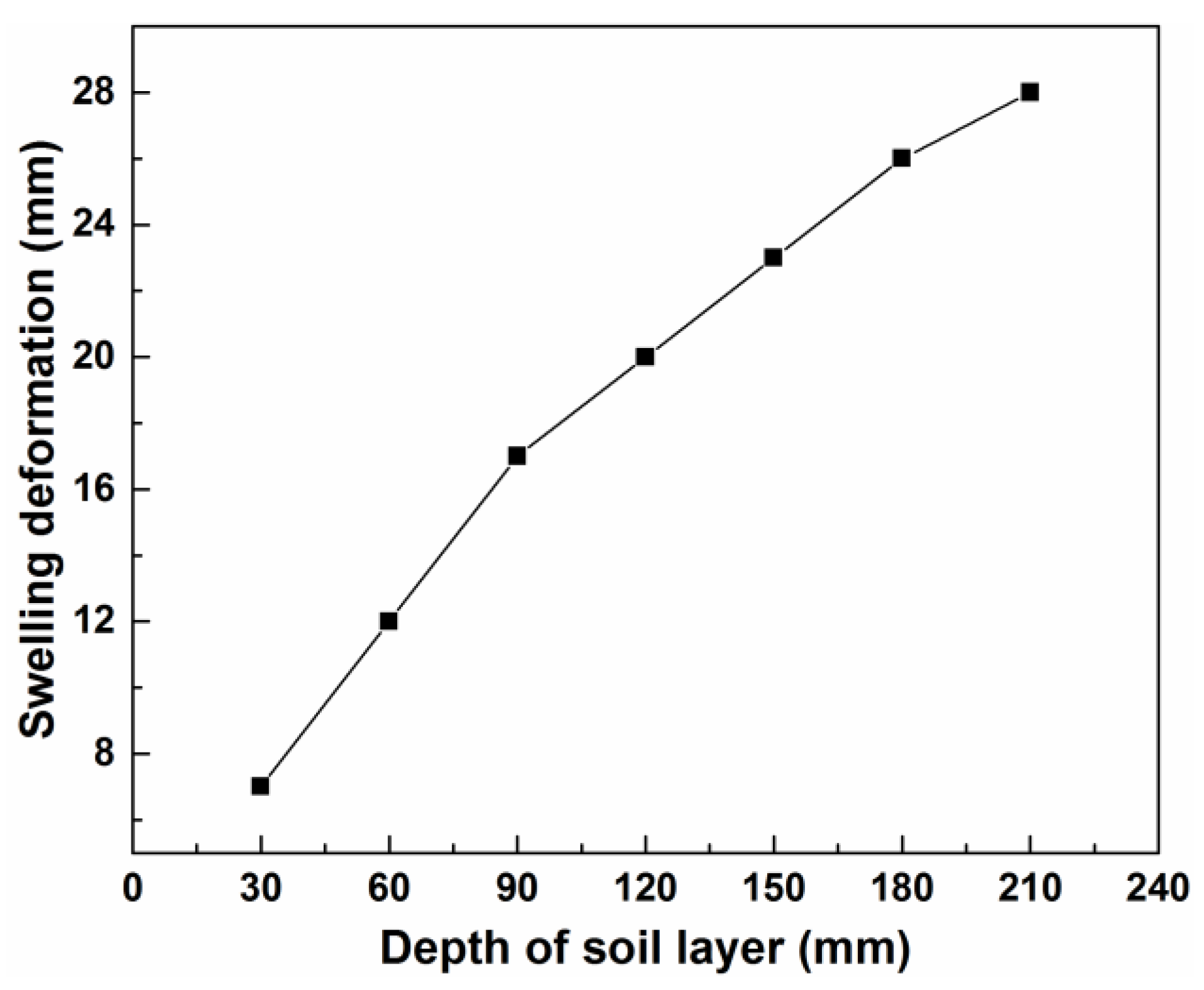
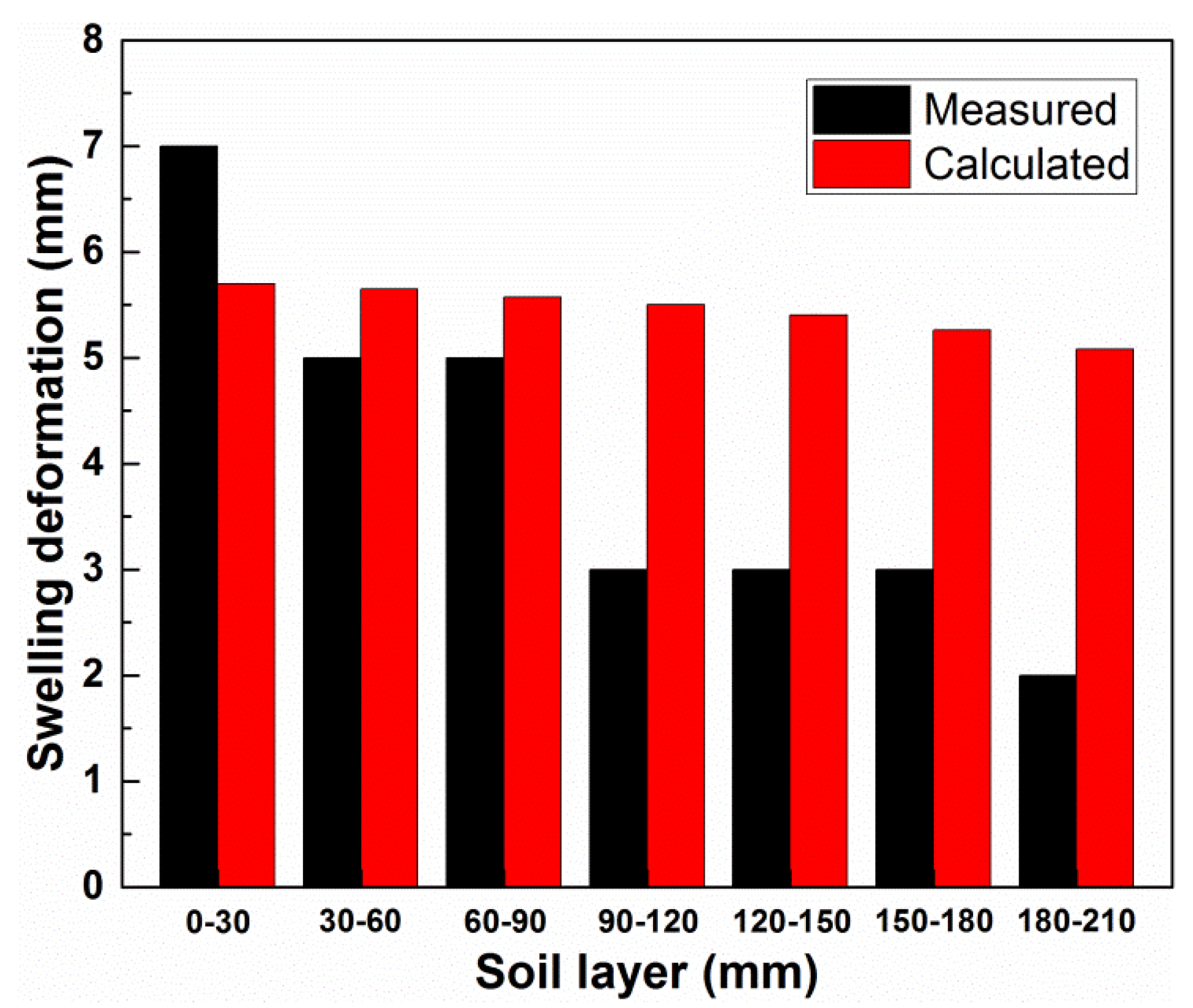
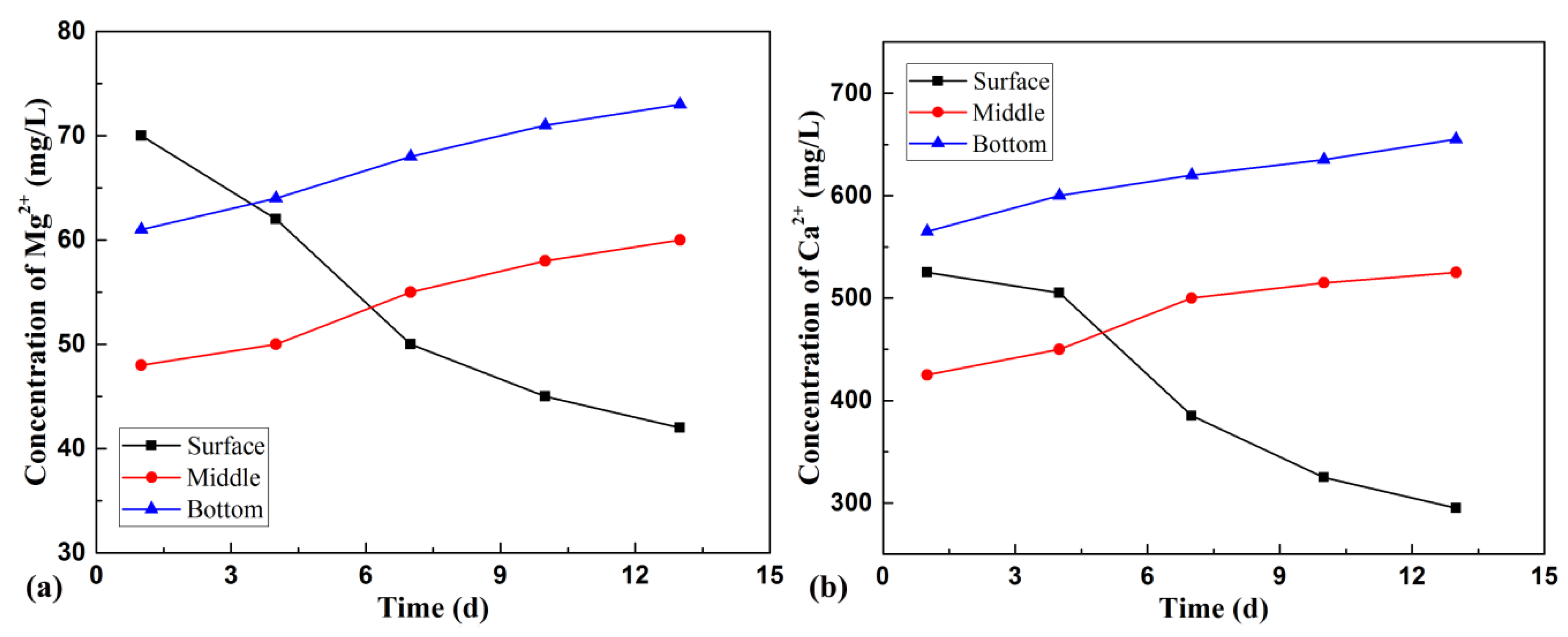
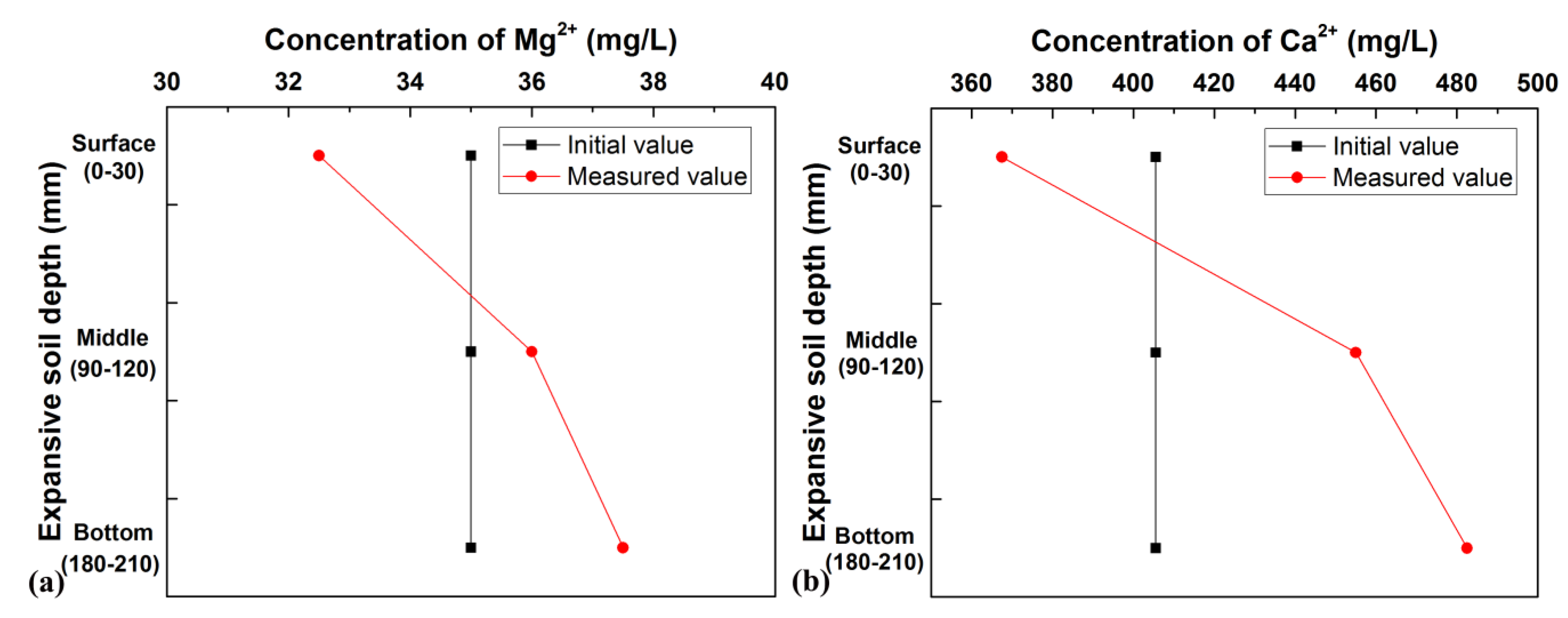
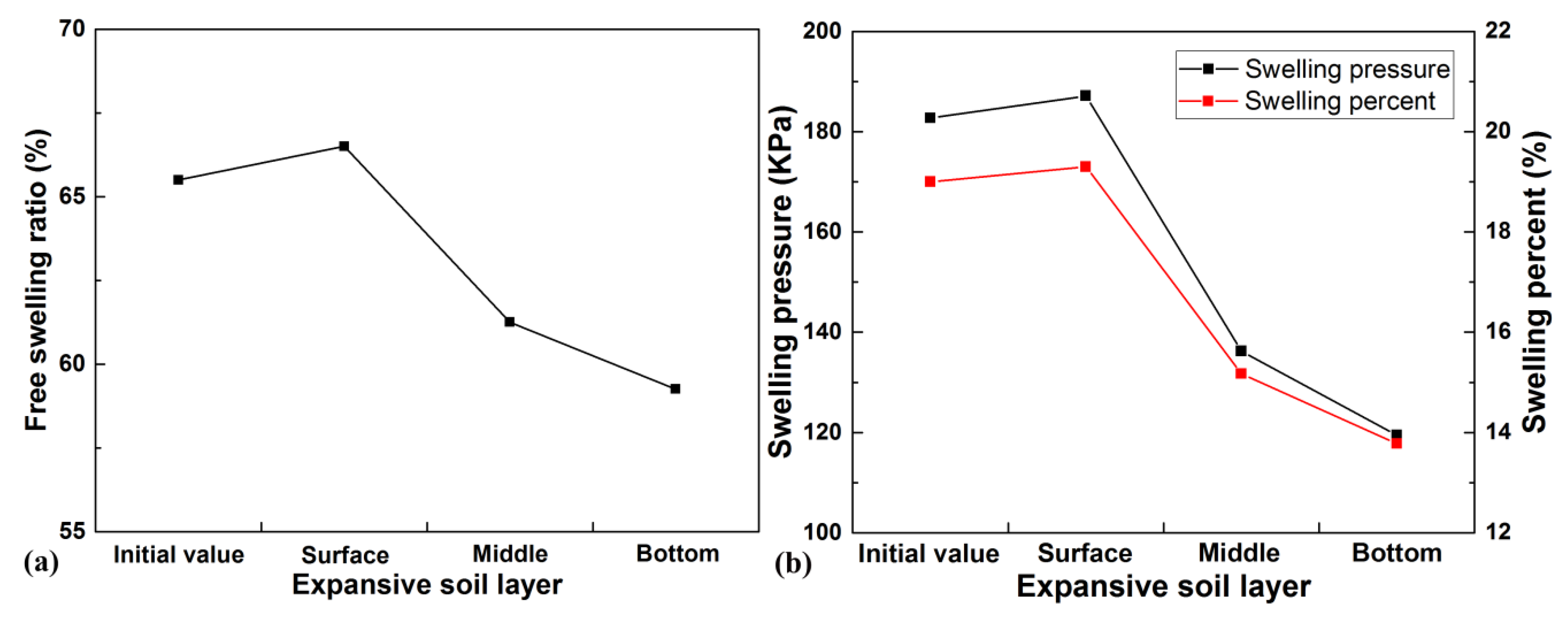
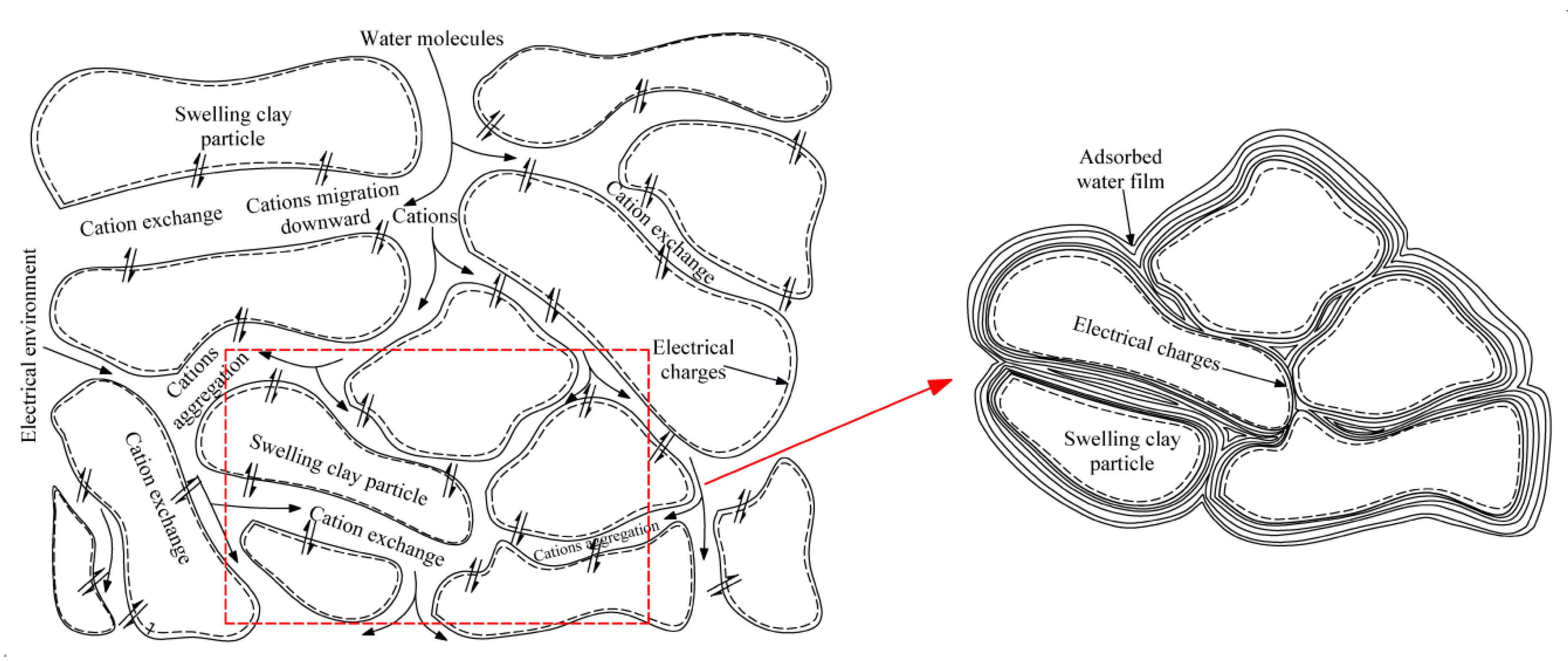
| Property | Expansive Soil |
|---|---|
| Grain size distribution | |
| Sand (%) | 3.90 |
| Silt (%) | 31.70 |
| Clay (%) | 64.40 |
| Specific gravity | 2.70 |
| Atterberg limits (%) | |
| Liquid limit | 63.00 |
| Plastic limit | 24.94 |
| Unified soil classification | CH |
| Compaction properties (standard Proctor) | |
| Optimum moisture content (%) | 16.20 |
| Maximum dry density (g/cm3) | 1.80 |
| Swell properties | |
| Free swelling ratio (%) | 65.50 |
| Swelling pressure (KPa) | 182.72 |
| Swelling percent (%) | 19.00 |
| Main minerals | |
| Montmorillonite (%) | 23.17 |
| Kaolinite (%) | 5.93 |
| Quartz (%) | 59.65 |
| Calcite (%) | 11.25 |
| Main cations of pore solution (mg/L) | |
| Na+ | 12.50 |
| K+ | 10.00 |
| Mg2+ | 35.00 |
| Ca2+ | 405.50 |
© 2019 by the authors. Licensee MDPI, Basel, Switzerland. This article is an open access article distributed under the terms and conditions of the Creative Commons Attribution (CC BY) license (http://creativecommons.org/licenses/by/4.0/).
Share and Cite
She, J.; Lu, Z.; Yao, H.; Fang, R.; Xian, S. Experimental Study on the Swelling Behavior of Expansive Soil at Different Depths under Unidirectional Seepage. Appl. Sci. 2019, 9, 1233. https://doi.org/10.3390/app9061233
She J, Lu Z, Yao H, Fang R, Xian S. Experimental Study on the Swelling Behavior of Expansive Soil at Different Depths under Unidirectional Seepage. Applied Sciences. 2019; 9(6):1233. https://doi.org/10.3390/app9061233
Chicago/Turabian StyleShe, Jianbo, Zheng Lu, Hailin Yao, Ran Fang, and Shaohua Xian. 2019. "Experimental Study on the Swelling Behavior of Expansive Soil at Different Depths under Unidirectional Seepage" Applied Sciences 9, no. 6: 1233. https://doi.org/10.3390/app9061233
APA StyleShe, J., Lu, Z., Yao, H., Fang, R., & Xian, S. (2019). Experimental Study on the Swelling Behavior of Expansive Soil at Different Depths under Unidirectional Seepage. Applied Sciences, 9(6), 1233. https://doi.org/10.3390/app9061233




